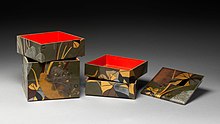Jūbako: Difference between revisions
Content deleted Content added
Notability, Speedy delete, and uncategorized Notice added |
mNo edit summary Tags: Mobile edit Mobile app edit iOS app edit |
||
| (18 intermediate revisions by 14 users not shown) | |||
| Line 1: | Line 1: | ||
{{Short description|Japanese food box}} |
|||
| ⚫ | |||
{{Italic title|reason=[[:Category:Japanese words and phrases]]}} |
|||
| ⚫ | |||
| ⚫ | |||
'''Jūbako''' ('''[[:ja:重箱|重箱]]''') are tiered boxes used to hold and present food in Japan.<ref>{{Cite book|url=https://books.google.com/books?id=YeWhAwAAQBAJ&lpg=PT107&dq=J%C5%ABbako%20tiered%20box&pg=PT107#v=onepage&q=J%C5%ABbako%20tiered%20box&f=false|title=Tea Cult Of Japan|last=Fukukita|date=2014-05-22|publisher=Routledge|isbn=9781317792642|language=en}}</ref> The boxes are often used to hold takeaway lunches, or [[bento]], or to hold [[osechi]], foods traditional to the [[Japanese New Year]]. |
|||
{{nihongo||[[wiktionary:重箱|重箱]]|'''Jūbako'''|lit. "tiered boxes"}} are tiered boxes used to hold and present food in Japan.<ref name="JPPRO_Dishware">{{Cite web|url=https://www.gov-online.go.jp/eng/publicity/book/hlj/html/202101/202101_02_en.html|title=Food and Dishware as Landscapes|date=2021-01-02|access-date=2021-08-11|website=Highlighting Japan|archive-url=https://web.archive.org/web/20210120090835/https://www.gov-online.go.jp/eng/publicity/book/hlj/html/202101/202101_02_en.html|archive-date=2021-01-20|url-status=live|publisher=Public Relations Office of the Government of Japan}}<!--ignore the blurry photos--></ref> The boxes are often used to hold ''[[osechi]]'', foods traditional to the [[Japanese New Year]],<ref name="EmbJapanNY_Osechi">{{Cite web|url=https://www.ny.us.emb-japan.go.jp/japaninfo/dec2016/03.html|title=Osechi-ryori: The New Year's Feast|date=2020-11-26|access-date=2021-08-11|website=Consulate General of Japan in New York|archive-url=https://web.archive.org/web/20170714232934/http://www.ny.us.emb-japan.go.jp/japaninfo/dec2016/03.html|archive-date=2017-07-14|url-status=live|orig-year=2016}}</ref> or to hold takeaway lunches, or [[bento]]. |
|||
| ⚫ | |||
{{anchors|sagejū|sageju|sagejuu|sagejūbako|sagejbako|sagejuubako}} |
|||
A {{nihongo3|lit. "portable ''jūbako''"|提重|''sagejū''}} or {{nihongo3||提げ重箱|''sagejūbako''}}, is a picnic set of ''jūbako'' in a carrier with handle.<ref name="MetMuseum57588">{{Cite web|url=https://www.metmuseum.org/art/collection/search/57588|title=Portable Picnic Set (sagejū) with Chrysanthemums, Foliage Scroll, and Tokugawa Family Crest 18th century|website=Metropolitan Museum of Art}}</ref> |
|||
{{anchors|jikirō|jikiro}} |
|||
There is also {{nihongo3|lit. "food basket"|食籠|''jikirō''}}, a kind of chinese styled bowl,<ref name="KyotoMuseum_SanoChokan">{{Cite web|url=https://www.kyohaku.go.jp/eng/dictio/shikki/51sano.html|title=The Lacquer Artisan Sano Chokan|access-date=2021-08-11|website=Kyoto National Museum|archive-url=https://web.archive.org/web/20180824144745/http://www.kyohaku.go.jp/eng/dictio/shikki/51sano.html|archive-date=2018-08-24|url-status=live}}</ref> some stackable like ''jūbako''.<ref name="Lawrence1895">{{Cite book|title=Catalogue of the collection of Japanese works of art : formed between the years 1869 and 1894|last=Lawrence|first=Trevor|publisher=(privetely printed)|year=1895|url=https://babel.hathitrust.org/cgi/pt?id=yale.39002044802859&view=1up&seq=205&skin=2021&q1=Jikir%C5%8D|editor-last=Huish|editor-first=Marcus B.|editor-link=Marcus Bourne Huish|at=p89: item 1186; p82: item 1186|language=en|author-link=Sir Trevor Lawrence, 2nd Baronet|hdl-access=free|hdl=2027/yale.39002044802859?urlappend=%3Bseq=205}}</ref> |
|||
==Gallery== |
|||
<gallery> |
|||
| ⚫ | |||
File:菊唐草葵紋蒔絵提重-Portable Picnic Set (sagejū) with Chrysanthemums, Foliage Scroll, and Tokugawa Family Crest MET DP154362.jpg|Sagejū |
|||
File:Round food box on high foot ring (jikiro) with design of peonies, Ryukyu Islands, 16th-17th century AD, red and black lacquer with chinkin on wood - Ethnological Museum, Berlin - DSC02082.JPG|Jikirō |
|||
</gallery> |
|||
==See also== |
|||
*[[Tiffin carrier]]: tiered lunchbox of India and the Caribbean |
|||
==References== |
==References== |
||
{{reflist}} |
|||
<references />{{Uncategorized}} |
|||
==External links== |
|||
| ⚫ | |||
{{Japanese food and drink|state=autocollapse}} |
|||
[[Category:Food packaging]] |
|||
Latest revision as of 18:16, 26 November 2023

Jūbako (重箱, lit. "tiered boxes") are tiered boxes used to hold and present food in Japan.[1] The boxes are often used to hold osechi, foods traditional to the Japanese New Year,[2] or to hold takeaway lunches, or bento.
A sagejū (提重, lit. "portable jūbako") or sagejūbako (提げ重箱), is a picnic set of jūbako in a carrier with handle.[3]
There is also jikirō (食籠, lit. "food basket"), a kind of chinese styled bowl,[4] some stackable like jūbako.[5]
Gallery[edit]
-
An 18th century wood, gold and silver foil jūbako
-
Sagejū
-
Jikirō
See also[edit]
- Tiffin carrier: tiered lunchbox of India and the Caribbean
References[edit]
- ^ "Food and Dishware as Landscapes". Highlighting Japan. Public Relations Office of the Government of Japan. 2021-01-02. Archived from the original on 2021-01-20. Retrieved 2021-08-11.
- ^ "Osechi-ryori: The New Year's Feast". Consulate General of Japan in New York. 2020-11-26 [2016]. Archived from the original on 2017-07-14. Retrieved 2021-08-11.
- ^ "Portable Picnic Set (sagejū) with Chrysanthemums, Foliage Scroll, and Tokugawa Family Crest 18th century". Metropolitan Museum of Art.
- ^ "The Lacquer Artisan Sano Chokan". Kyoto National Museum. Archived from the original on 2018-08-24. Retrieved 2021-08-11.
- ^ Lawrence, Trevor (1895). Huish, Marcus B. (ed.). Catalogue of the collection of Japanese works of art : formed between the years 1869 and 1894. (privetely printed). p89: item 1186; p82: item 1186. hdl:2027/yale.39002044802859.



